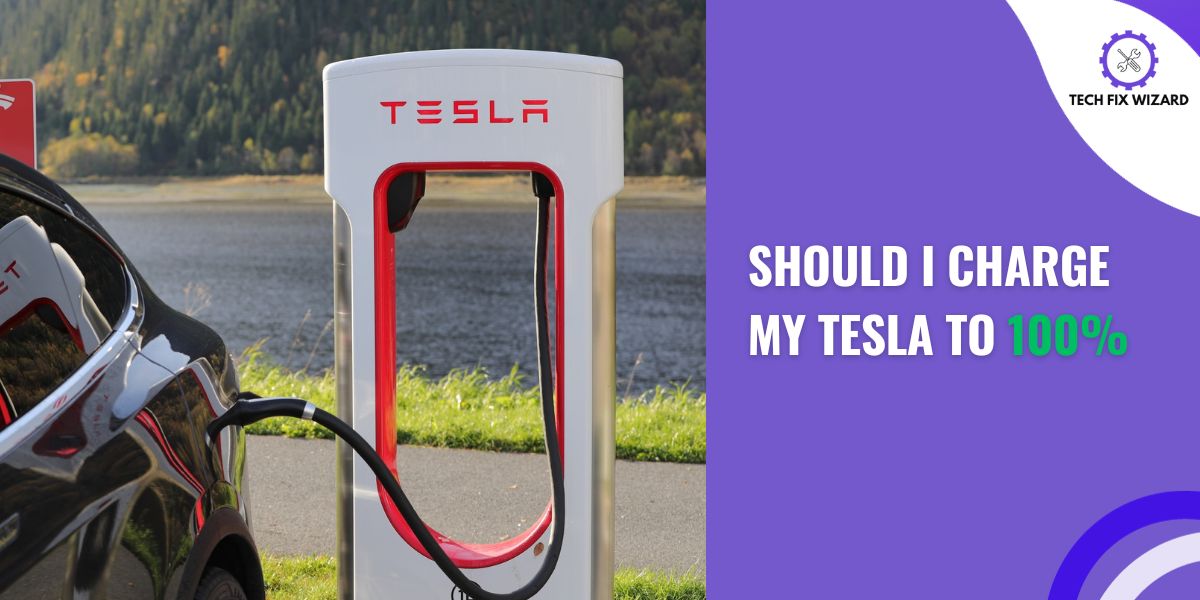The question echoes in the minds of Tesla owners frequently, “Should I charge my Tesla to 100%?” It’s a puzzle that needs careful consideration and exploration.
In this article, we’re going to break down this question and help you understand whether maxing out your Tesla’s charge is a smart choice.
By the end, you’ll have a clear idea of whether going all the way to 100% is the way to go or if there’s a better option for your Tesla.
Contents
- 1 Most Common Tesla Charging Questions – Tips and Insights
- 2 1. Should I Charge My Tesla to 100%?
- 3 2. Is Charging Tesla to 100% Once a Week a Good Idea?
- 4 3. How Bad Is Charging Tesla 100%?
- 5 4. What are the Alternatives to 100% Charging?
- 6 5. At What Percentage Should I Charge My Tesla?
- 7 6. Should I Charge My Tesla Every Night?
- 8 7. What’s the Charge Limit for Tesla Model Y?
- 9 8. Is It Bad to Run Tesla Battery Low?
- 10 Optimize Your Tesla’s Battery with Range Mode Switch
- 11 FAQs
- 12 1. What’s the optimal charging range?
- 13 2. Is there a situation where a 100% charge is necessary?
- 14 3. How often can I charge 100%?
- 15 4. Can I leave my Tesla plugged in after reaching 100%?
- 16 5. What about daily supercharging?
- 17 6. Does the type of charger matter?
- 18 7. How can I preserve battery health?
- 19 18. What if I need to charge 100% frequently?
Most Common Tesla Charging Questions – Tips and Insights
Let’s address some of the most common questions that Tesla owners frequently raise regarding the charging of their vehicles.
1. Should I Charge My Tesla to 100%?
The short answer to this question would be, “No, you shouldn’t charge it to 100% regularly.” No doubt the “full tank” feeling might be tempting, but consistently charging your Tesla to 100% can wear down its battery health over time.
Batteries, just like us, appreciate a balance. Going all the way to 100% repeatedly might provide a temporary boost in range, but it also exposes the battery to extra stress and heat, contributing to long-term degradation.
It’s better to find a middle ground that keeps your battery content healthy. However, an occasional full charge won’t cause major harm.
Trending Post: How To Fix Tesla Touchscreen Not Working – Here’s How To Fix It!
2. Is Charging Tesla to 100% Once a Week a Good Idea?
Charging your Tesla to 100% once a week is not harmful to the battery. However, it is best to avoid charging 100% more than once a week if possible.
Here are some of the things to consider when deciding how often to charge your Tesla to 100%:
- Your driving habits. If you only drive short distances daily, you probably don’t need to charge 100% very often.
- Your climate. If you live in a cold climate, you may need to charge 100% more often to compensate for the loss of range due to the cold weather.
- Your battery health. If your battery is old or has been damaged, you may need to charge to 100% less often to prevent further damage.
3. How Bad Is Charging Tesla 100%?
Charging your Tesla to 100% can put a little bit of stress on the battery and can shorten its lifespan. If you need to charge 100% more than once a week, you may want to consider lowering your charge limit.
Here are some of the things to consider when deciding how often to charge your Tesla to 100%:
- The age of your battery. Older batteries are more susceptible to damage from charging to 100%.
- Your driving habits. If you only drive short distances daily, you probably don’t need to charge 100% very often.
4. What are the Alternatives to 100% Charging?
If you need to travel a long distance and need maximum range, there are a few alternatives to 100% charging that you can consider.
| No. | Charging and Driving Tips | Description |
|---|---|---|
| 1. | Supercharging | A fast charging network that Tesla has built. Supercharging can charge your battery to 80% in about 20 minutes.
It’s a great option if you need a quick charge as Tesla takes time when charging from 90% onwards, but keep in mind that it may not be as gentle on the battery as slower charging methods. |
| 2. | Preconditioning | Preconditioning involves warming up the battery before you start driving. This can improve battery efficiency and extend its range.
You can precondition your battery by setting the climate control to a warm temperature before you begin your drive. |
| 3. | Driving Conservatively | Driving conservatively is a strategy that helps improve the efficiency of your Tesla and extend its range.
This entails avoiding hard acceleration and braking and maintaining a consistent speed. By doing so, you can significantly enhance overall battery efficiency. |
A Quick Read: Tesla Not Connecting To Wi-Fi – 8 Quick Fixes
5. At What Percentage Should I Charge My Tesla?
Tesla recommends charging your battery between 20% and 90% for optimal battery health. Charging 100% is only necessary when you need to go on a long road trip.
Here are some of the reasons why it’s best to charge your Tesla between 20% and 90%:
- Charging to 100% stresses the battery, shortening its lifespan due to increased heat at full charge.
- Charging to 20% strains the battery too, leading to capacity loss.
- Maintaining a 20-90% charge range optimizes battery life and performance by avoiding excessive stress from overcharging or undercharging.
- Charging to 80% is generally sufficient for daily driving, eliminating worries about running low before reaching your destination.
- If 100% charge is needed, do so infrequently—around once a week—to minimize battery wear and tear.
6. Should I Charge My Tesla Every Night?
Yes, it is a good idea to charge your Tesla every night. This will help to keep the battery topped off and will extend its lifespan.
You can also set your Tesla to charge automatically overnight so you don’t have to worry about it.
Here are some of the benefits of charging your Tesla every night:
- It will help keep the battery topped off and prevent it from getting too low.
- It will extend the battery’s lifespan.
- It will make it more convenient to start your day with a full charge.
- It will save you money on electricity costs in the long run.
Also See: How To Fix Tesla Speakers Not Working – Try These 8 Fixes
7. What’s the Charge Limit for Tesla Model Y?
The charge limit for a Tesla Model Y is 90%. This is the maximum percentage that you should charge your battery to for optimal battery health.
Here are some of the reasons why Tesla recommends a 90% charge limit for the Model Y:
- It will help to extend the battery’s lifespan.
- It will prevent the battery from getting too hot, which can damage the cells.
- It will make it easier to maintain the battery’s range.
- It will reduce the risk of the battery catching fire.

8. Is It Bad to Run Tesla Battery Low?
Yes, it is bad to run your Tesla battery low. Tesla recommends keeping the battery between 20% and 90% for optimal performance and longevity. Running the battery below 20% can stress the battery and shorten its lifespan.
Here are some of the reasons why it is bad to run your Tesla battery low:
- It can damage the battery. When a lithium-ion battery is drained too low, it can damage the cells in the battery.
- It can increase the risk of thermal runaway. Thermal runaway is a dangerous condition that can occur in lithium-ion batteries. It happens when the battery gets too hot and starts to malfunction. Thermal runaway can cause the battery to catch fire or explode.
- It can reduce the battery’s efficiency. When a battery is drained too low, it becomes less efficient. This means that it takes more energy to power the car.
- It can increase the risk of a breakdown. If the battery is too low, the car may not start or it may not have enough power to reach its destination.
If you are going to be driving for a long period of time, it is important to make sure that your Tesla battery is fully charged. You can also use the car’s built-in battery management system to help you avoid running the battery too low.
Popular Reads:
Optimize Your Tesla’s Battery with Range Mode Switch
To maximize your Tesla’s range, switch to Range Mode for an optimized driving experience. Range Mode is a feature that adjusts various settings in your Tesla to prioritize energy efficiency and extend the battery’s range.
By activating this mode, you can significantly increase the distance you can travel on a single charge.
Following are a few more points you should know about Range Mode:
| No. | Range Mode Benefits | Description |
|---|---|---|
| 1. | Range Mode Drawbacks | While employing Range Mode might lead to slight adjustments in your driving experience, such as a slight reduction in acceleration or slightly elevated cabin temperature, the advantages significantly surpass these minor inconveniences. |
| 2. | Extended Travel Range | By utilizing Range Mode, you’ll be able to journey longer distances without the need for frequent recharges.
This can be particularly advantageous during road trips or extended drives. |
| 3. | Environmental Impact | Opting for Range Mode aids in creating a more sustainable future by minimizing your carbon footprint.
This choice aligns with Tesla’s mission of promoting eco-friendly transportation. |
| 4. | Regenerative Braking and Efficiency | Tesla’s innovative regenerative braking system and efficient electric motors continue to operate effectively in Range Mode.
This means that even with the mode activated, you can still expect a smooth and responsive driving experience. |
FAQs
1. What’s the optimal charging range?
For optimal battery longevity, it’s best to keep your Tesla battery level within the range of 20-80% for regular daily driving. This reduces the stress on the battery and helps extend its overall lifespan.
2. Is there a situation where a 100% charge is necessary?
Yes, there are situations where a 100% charge is useful, such as before embarking on a long road trip. However, it’s advisable to initiate this charge shortly before you begin your journey to minimize the time spent at the maximum charge.
3. How often can I charge 100%?
Frequent 100% charges should be avoided to preserve battery health. Infrequent instances, such as before a planned long trip, are less likely to cause significant degradation. Tesla’s Battery Management System helps mitigate some effects of high charge levels.
4. Can I leave my Tesla plugged in after reaching 100%?
While Tesla’s Battery Management System controls the charging process, it’s still a good practice to unplug your Tesla once it reaches 100%. This minimizes the duration it spends at full charge, which can contribute to prolonged battery life.
5. What about daily supercharging?
Daily supercharging, especially to 100%, can accelerate battery degradation due to the high charging speeds involved. Reserve supercharging for longer trips and use it sparingly for daily charging.
6. Does the type of charger matter?
Yes, the type of charger matters. Using a Level 2 charger (commonly found at home) is gentler on the battery compared to a Level 3 supercharger, which delivers higher power and can heat the battery more quickly.
7. How can I preserve battery health?
To preserve your Tesla’s battery health, avoid subjecting it to extreme temperatures. Precondition the battery before using superchargers in very hot or cold conditions. Additionally, try to avoid letting the battery sit at extremely low or high charge levels for extended periods.
18. What if I need to charge 100% frequently?
If your driving patterns require frequent 100% charges, it’s a good idea to reach out to Tesla’s customer support. They might be able to provide tailored advice based on your specific usage and help you find the best compromise between battery health and your driving needs.

John Paul is a tech enthusiast dedicated to troubleshooting. He is passionate about fixing glitches, simplifying complexities, and empowering others in the digital realm.

